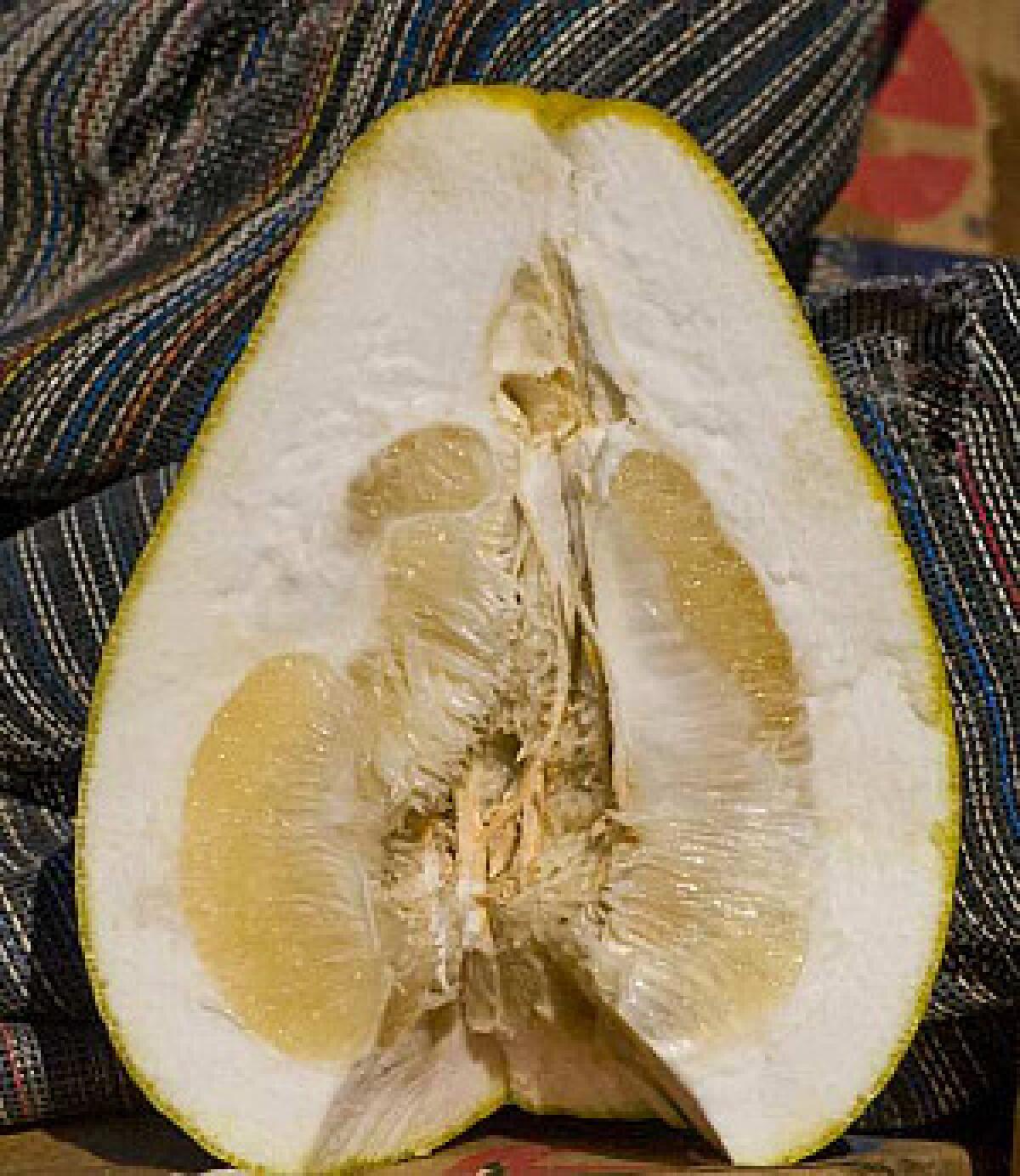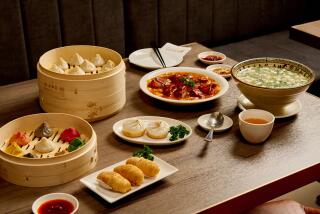Alhambra farmers market: pummelos for Chinese New Year

The scores of customers who join the long line at the Alhambra farmers market on Sunday mornings to buy Jerry Dimitman’s Wong pummelos all know the drill: Get there early, and be prepared to wait as each shopper scrutinizes the giant pear-shaped citrus fruits, holding them in the hand, one by one, to judge their weight, looking for heavy, shapely specimens. Plenty of pummelos are grown in California, but most are the flat, pink-fleshed Chandler variety. And especially as Chinese New Year approaches -- it will be Sunday, Feb. 14, this year, the Year of the Tiger -- many Chinese Americans seek out the necked, yellow-fleshed fruits they remember from their homeland. Asians give them as offerings at temple altars, where their gold color symbolizes prosperity; they also peel and eat them, carefully removing the tough, bitter membrane from each section.
Native, like most citrus, to southern China and southeastern Asia, the pummelo (sometimes spelled “pomelo”) is the mother of the grapefruit, and one of the three primary species of cultivated citrus, from which other types developed by hybridization and mutation. Compared with a grapefruit it is larger and has a much thicker rind and somewhat drier, milder pulp.
Dimitman, a retired professor of plant pathology at Cal Poly Pomona, named his most successful pummelo variety Wong, after a friend, the late Ben Wong, who owned a restaurant in Alhambra and brought in budwood of the variety from China in the 1940s. (Today such importations are more strictly controlled, and smuggling threatens to devastate California’s citrus industry by introducing new pests and diseases.)
For Dimitman it was part of a keen interest in many then-exotic fruits that appealed to Asians but were not grown in California, at least on a commercial scale. He planted the hillsides below his home overlooking the San Gabriel Valley with lychees, longans and wampi (a citrus relative), as well as special varieties of pummelos and mandarins, and named the farm Kwa Luk Gardens, after a celebrated lychee variety. He also planted citrus at the home of his wife, Emma, in Fallbrook, which is where most of the pummelos he sells at the Alhambra farmers market come from.
Dimitman is now 89, and his health is precarious, but he is determined to continue selling his pummelos at Alhambra as long as possible, largely because his many Chinese friends, some of whom help him at the market, would be disappointed if he stopped coming. His son Robert lives with him at Kwa Luk Gardens and plays a leading role in harvesting the fruit and managing logistics, and his other children, Susan and Steven, also help. Judging by the smiles on the faces of shoppers as they walk away from his stand with their chosen pummelos, their filial piety is a tradition well worth maintaining.
Chanterelles
With the recent rains, a bumper crop of local chanterelles abounds at the Wednesday Santa Monica farmers market. Three vendors from Lompoc -- Tutti Frutti Farms, Louis Mello and Mario Trevino -- have been selling hundreds of pounds a week of the fungi, at prices ranging from $10 to $18 a pound.
“This has been an exceptional season because of the rain,” Mello says. “We haven’t had such a bountiful harvest in a long time.”
Chanterelles are true wild mushrooms, prized for their lovely orange-gold color, graceful shapes and delicate but rich taste and aroma, which can run from apricot to nutty to peppery. They go well in sauces, but a simple preparation, like sauteing in butter, shows them off best.
Until recently this impressive and beautiful local mushroom was considered just a variant form of Cantharellus cibarius, the common golden chanterelle found in Europe and many areas of the United States, but an article by David Arora and Susie M. Dunham published in Economic Botany in 2008 reclassified it as its own new species, the California oak chanterelle, C. californicus. It is the largest chanterelle in the world -- some specimens weigh up to 2 pounds -- and grows almost exclusively in association with its mycorrhizal hosts, the coast live oak and a few other oak species; it occurs from northern Baja California to Mendocino County but is most abundant in the coastal hills of the Lompoc-San Luis Obispo region.
Despite differences in size, form and habitat, the flavor of the California oak chanterelle is “comparable in every respect” to that of the other chanterelle species, says Mohamad Ismail, a member of the Los Angeles Mycological Society who has a masters degree in mycology and runs Pacific Exotic Mushrooms, a business selling to restaurants. However, he says, the larger California chanterelles tend to be more moist, and some chefs prefer the smaller species, because they are easier to present whole on the plate and don’t have to be diced.
For best quality, shoppers should look for firmer, rounder button-shaped chanterelles, which tend to be younger, drier and less slimy than big cup-shaped specimens, says Chris Caldwell of Tutti Frutti Farms, who also sells at the Hollywood, Ojai and Santa Barbara markets. A lot of work goes into cleaning the chanterelles, which are then cured for a few days, so that they lose excess moisture and don’t express liquid in the pan when cooked, he adds.
More to Read
Eat your way across L.A.
Get our weekly Tasting Notes newsletter for reviews, news and more.
You may occasionally receive promotional content from the Los Angeles Times.






